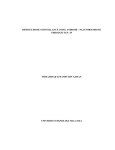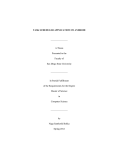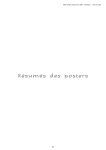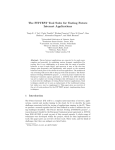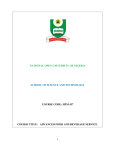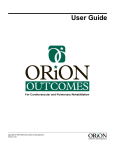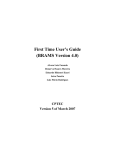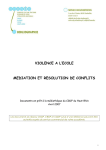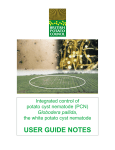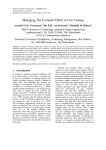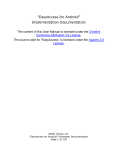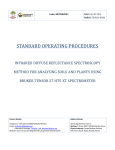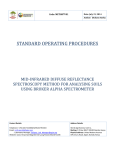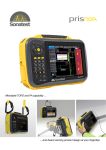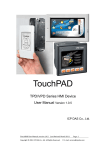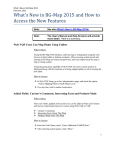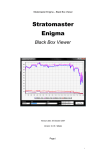Download Horticultural crops information dissemination in Kenya using mobile
Transcript
UNIVERSITY OF NAIROBI
SCHOOL OF COMPUTING & INFORMATICS
MSc. CS PROJECT: Application Development
HORTICULTURAL CROPS INFORMATION DISSEMINATION IN KENYA
USING MOBILE APPLICATION.
Wainaina Joyce Wangui
P58/66304/2011
Supervisor: Dr. Robert Oboko
A research submitted to the School of Computing and Informatics in partial fulfillment of the
requirement for the award of Masters of Science in Computer Science of the University of
Nairobi.
JULY, 2013
Declaration
This project is my original work and to the best of my knowledge, it has not been presented for a
degree in any other university.
Joyce Wangui Wainaina
Signed ...................................................
Date .......................................................
This project has been submitted as part fulfillment of requirements for the award of Masters of
Science in Computer Science of the School of Computing and Informatics of the University of
Nairobi, with my approval as the University Supervisor.
Dr. Robert Oboko
Signed ...................................................
Date .......................................................
i
Abstract
In Kenya some horticultural crops are rarely grown because farmers lack information on growing
them. The research has established that unreliable sources of pre-harvest information have
greatly affected the production of strawberry and mushroom in the country.
This study aimed at developing a mobile application which can assist strawberry and mushroom
farmers in Kenya by providing them with pre-harvest information about the crops. The study
also sought to provide a way of accessing the information by farmers efficiently and effectively.
This study outlines the development of a mobile application which contains information on
Strawberry and Mushroom crops. Various categories of the two crops were developed and their
details given. This was to ensure that farmers could easily access the information they need
regarding the crops. Use of videos and images was integrated in the application for ease of
understanding the concepts.
The study found out that horticultural farmers can use the developed mobile application
effectively considering the findings of the usability subscales evaluated of efficiency, affect,
control, learn ability and helpfulness.
ii
Acknowledgements
I would wish to thank the Almighty God for standing with me and giving me the strength to
pursue my study.
I wish to acknowledge my husband, Cyrus Muiru for giving me ample time and support during
the entire study. To my father, my two mothers and my siblings, thank you for your prayers and
encouragement during the entire time I was conducting the project.
To my supervisor, Dr Robert Oboko, thank you for always being available throughout my
research project, listening, giving me supportive advice and insight on my project.
Mr Robert Gitau of Rogita Plants Care Consultants, Mr. Stanley Kinyanjui and Mr.Stephen
Kamau of COSDEP, I appreciate your support for being key informants of my study data.
To my colleagues Stephen Mwaura and Nicholas Kakwe thank you for your support in various
stages of the project.
My classmate Purity Mayaka thank you for your assistance during field work and Erick Kiilu for
your unwavering support in editing the study report.
I wish to appreciate others whom I have not mentioned here, who contributed to this project in
one way or another.
May God bless you all.
iii
Table of Contents
Declaration..................................................................................................................................................... i
Abstract......................................................................................................................................................... ii
Acknowledgements...................................................................................................................................... iii
Table of Contents......................................................................................................................................... iv
List of Figures .............................................................................................................................................. vi
List of Tables .............................................................................................................................................. vii
Abbreviations and Acronyms .................................................................................................................... viii
CHAPTER 1: INTRODUCTION ................................................................................................................. 1
1.1
Background to the problem........................................................................................................... 1
1.2
Problem statement......................................................................................................................... 2
1.2.1
Purpose of the project ........................................................................................................... 3
1.3
Significance of the Study .............................................................................................................. 4
1.4
Research objectives....................................................................................................................... 4
1.4.1
General Objective ................................................................................................................. 4
1.4.2
Specific Objectives ............................................................................................................... 4
1.5
Assumptions.................................................................................................................................. 4
1.6
Definitions of important terms ...................................................................................................... 4
CHAPTER 2: LITERATURE REVIEW ...................................................................................................... 6
2.1
Introduction................................................................................................................................... 6
2.2
Mobile Phones .............................................................................................................................. 7
2.3
Hindrances to Information Accessibility in rural areas................................................................. 7
2.4
Mobile Applications...................................................................................................................... 9
2.4.1
Mobile Applications Platforms ...........................................................................................10
2.4.2
Importance of quality user interface for mobile application ...............................................11
2.5
Current Kenyan Mobile Applications in Horticulture ................................................................13
2.5.1
M-Farm mobile application ................................................................................................13
2.5.2
M-Kilimo ............................................................................................................................14
2.5.3
Summary of existing applications.......................................................................................14
2.6
Mobile Application Development Guide ....................................................................................14
2.6.1
Needs Assessment...............................................................................................................15
2.6.2
Storyboarding......................................................................................................................16
2.6.3
Server / Client Unified Modeling Language (UML) Flow .................................................16
2.6.4
Design ................................................................................................................................. 16
2.6.5
Offline / Online Development:............................................................................................16
2.6.6
Testing phase of the developed application. ....................................................................... 17
2.6.7
Signing Process: Process of encoding a digital certificate into the application. .................17
2.6.8
Application Distribution: Application delivery to the segmented users. ............................17
iv
2.6.9
Regular Updates:.................................................................................................................17
2.7
Android Application Development Methodologies .................................................................... 17
2.7.1
Agile Methodology ............................................................................................................. 17
2.7.2
Waterfall Methodology ....................................................................................................... 18
2.7.3
Extreme Programming ........................................................................................................ 18
2.7.4
Rapid Action Development................................................................................................. 18
2.8
Conceptual Design ......................................................................................................................19
2.9
Literature Summary ....................................................................................................................19
CHAPTER 3: METHODOLOGY .............................................................................................................. 21
3.1
Mobile Application Development...............................................................................................21
3.1.1
Introduction.........................................................................................................................21
3.1.2
Agile Methodology ............................................................................................................. 22
3.1.3
Development of design scenarios and use cases ................................................................. 25
3.1.4
Application Development ................................................................................................... 31
3.2
Research Methodology ...............................................................................................................33
3.2.1
Introduction.........................................................................................................................33
3.2.2
Usability Evaluation............................................................................................................ 33
3.2.3
Instrument Development and pre-testing ............................................................................ 33
3.2.4
Population ...........................................................................................................................35
3.2.5
Sampling .............................................................................................................................35
3.2.6
Data Collection ...................................................................................................................35
3.2.7
Data Analysis ......................................................................................................................35
3.2.8
Data Presentation and interpretation ...................................................................................36
CHAPTER 4: CONCLUSION AND RECOMMENDATIONS ................................................................42
4.1
Conclusion .................................................................................................................................. 42
4.2
Key Achievements ......................................................................................................................42
4.3
Limitations of the study .............................................................................................................. 43
4.4
Recommendations.......................................................................................................................43
4.5
Suggestions for Further Research ...............................................................................................43
REFERENCES ........................................................................................................................................... 44
APPENDICES ............................................................................................................................................ 49
APPENDIX A: Interview Check List ..................................................................................................... 49
APPENDIX B: Application Usability Evaluation questionnaire............................................................50
APPENDIX C: Application Installation Manual (adapted from
http://vbraille.cs.washington.edu/doc/how_to_install_apks.pdf)............................................................52
APPENDIX D: User Manual on working with the application ..............................................................56
APPENDIX E: Sample Code..................................................................................................................59
v
List of Figures
Figure 1: Mobile Application Development Methodology Guide (Mobinex, 2010)…………….11
Figure 2: The design scenario of how horticultural mobile application works………...………..15
Figure 3: Adapted from Agile development methodology by Larman, C. (2004)…….……..….16
Figure 4: Scenario of the application administrator updating the content……….……………...19
Figure 5: Scenario of a user deploying application in mobile phone………………………..…20
Figure 6: Scenario of a user accessing information…………………………………………..…20
Figure 7: Structure of the application…………………………………………………………...21
Figure 8: Displaying application tools………………………………………………………….21
Figure 9: List of crops in the application……………………………………………………….22
Figure 10: User feedback form…………………………………………………………………22
Figure 11: Structure of the Strawberry information category………………………………….23
Figure 12: Structure of the Mushroom information category………………………………….23
Figure 13: Structure of various categories of the crops information…………………………..24
Figure 14: Bar Graphs showing the Affect subscale of usability…………………….……..…30
Figure 15: Bar Graphs showing efficiency subscale………………………………….……….31
Figure 16: Bar Graphs showing control subscale………………….………………….………32
Figure 17: Bar Graphs showing learn ability subscale…………………………………….….33
Figure 18: Bar Graphs showing helpfulness subscale ………………………………………..34
vi
List of Tables
Table 1: Structure of the application database…………………………………………………..24
Table 2: Results Table showing the Affect subscale of usability……………………………….29
Table 3: Result Table of Efficiency factor………………………………………………………30
Table 4: Result Table for control…………………………………………….………………….31
Table 5: Result Table for Learn ability subscale…………………………..….………………...31
Table 6: Result Table for Helpfulness subscale…………………………………………………33
vii
Abbreviations and Acronyms
ALIN
Arid Land Information Network
COSDEP
Community Sustainable Development Empowerment Programme
CCK
Communication Commission of Kenya
GDP
Gross Domestic Product
ICT
Information and Communication Technology
KNBS
Kenya National Bureau of Statistics
NGO
Non Governmental Organization
RAD
Rapid Action Development
SDLC
Software Development Life Cycle
SMS
Short Message Service
SUMI
Software Usability Measurement Inventory
UML
Unified Modeling Language
USSD
Unstructured Supplementary Service Data
WAP
Wireless Application Protocol
XP
Extreme Programming
viii
CHAPTER 1: INTRODUCTION
1.1
Background to the problem
In Kenya, Agriculture is one of the most important economic sectors contributing 24% to the
Gross Domestic Product (GDP) (KNBS, 2012). Majority of the Kenyan population practices
farming. The various farming activities they engage in include pastoralism, horticultural farming,
cash crop farming and subsistence farming. A significant number of crop farmers in Kenya
practice horticultural farming. These farmers need reliable and accessible source of information
on best farming practices and techniques, diseases and their control measures. The information
should be timely and convenient regardless of the location of the users.
Agricultural extension Officers from the Ministry of Agriculture provides this information
directly to the farmers through the Ministry’s website, farm visits, during farmers’ field days
practical trainings to groups and individual farmers. However, these means of availing
information to farmers have been facing challenges, mainly due to scarcity of Agricultural
Extension officers from the Ministry of Agriculture resulting to infrequent and unreliable
farming information. According to Kibett, J.K., et al, (2005), one extension officers currently
serves 1,000 farmers instead of the recommended 400 farmers
With the increasing emergence and use of modern technologies, devices such as mobile phones
have become common gadgets in our society. According to quarterly statistics report of
Communication Commission of Kenya (CCK), at the end of second Quarter of the 2012/13
financial year, a total of 30.7 Million subscribers were registered on the mobile network
representing a marginal growth of 1.0 percent from the last quarter. Mobile penetration stood at
78.0 percent during the period up from 77.2 percent recorded during the previous period. Talbot
(2011) reported that Android phones are increasing in the Kenyan market and are becoming
more affordable with more than 350,000 Android users. Thus most people (including farmers)
own or have access to Android mobile phones. Mobile phones can be used to meet the rising
demand of information by crop farmers by providing access to mobile applications that can assist
them in accessing information regarding farming activities such as diagnosing diseases affecting
1
their crops and possible solutions to the diseases. This in return would improve their yield
leading to the betterment of Kenya’s economy.
Mobile phones can be efficient in providing agricultural extension to farmers since they can be
accessed from anywhere, anytime and have a wider reach, Lawal-Adebowale & Akeredolu-Ale
(2010). However, making the information materials available on mobile phone becomes difficult
considering the physical form of the phones. Designing a mobile application that considers the
user interface challenges due to mobile phone size can enable the majority of the phone users to
access the information with ease, Christina W. (2010). This would improve delivery of the much
needed information and save the farmers the stress of accessing the information from their
mobile phones.
Considering the goals of the farmers and the context to which they may need information,
effective and efficient user interface for mobile application would greatly provide an effective
means of information dissemination to the farmers, Christina W. (2010). Studies have shown
that, effective user interface on mobile phones can promote access to information due to its wider
coverage. During this study, most of the existing mobile applications are based on unstructured
supplementary service data (USSD) which can only provide limited details in the data thus not
supporting appropriate interaction with the users(Long V., 2009). There is a need for an
agricultural information application that can provide more information in various forms like
videos, text and images.
1.2
Problem statement
Faced with the scarcity of Agricultural Extension officers from the Ministry of Agriculture, the
Government has not managed to keep pace with the growing number of farmers requiring
extension services like horticultural farming techniques, new farming practices among others.
One extension officers currently serves 1,000 farmers instead of the recommended 400 farmers
(Kibett, J.K., et al, 2005). The perceived impact of agricultural extension has grown low
2
according to African crop science society,(2005). This has led to farmers relying on their
traditional myths in identifying crop diseases when they are affected; for example farmers have
to travel long distances to seek solutions from government agricultural offices and private agro
vets, where they have to describe symptoms of the affected crops in order for them to get the
right agro-chemicals/ prescription . This leads to crop waste since farmers do not get the solution
to their problems on time. Others have to attend farm demonstrations or field-based trainings
which may take most of their time, use internet materials some of which may have misleading
information or Mobile based USSD code which are session based, provides limited details and
may be costly, Mobile Marketing 101 (2013).
Information dissemination to horticulture farmers is poor due to inefficient means of delivering
information. The highly valued and rare crops like mushroom and strawberry are rarely grown in
Kenya. This is because farmers have limited access to information on growing the two crops in
the country, or those who grow them fail to get expected yields due to challenges experienced
during their farming like using the best farming practices and controlling diseases affecting them.
1.2.1
Purpose of the project
The study involved developing a mobile application to avail information to horticultural farmers
to improve their farming skills and techniques. The research evaluated the developed mobile
applications for disseminating horticultural information to ensure that it meets the user
requirements and performed the intended functions.
The application disseminates crop information to farmers in an effective and efficient manner
suited to the farmers’ characteristics and context. The research would provide further awareness
to the application developers and other stakeholders like the Ministry of Agriculture, NonGovernmental Organizations interested in Agriculture and horticultural farmers. The latter can
rely on smart mobile phones to gain skills related to their crops using the mobile application or
use the information provided while doing their farming.
3
1.3
Significance of the Study
The key outcome of this research is a usable application that would disseminate new skills
and techniques on horticultural farming to farmers.
Implementation of the mobile application can overcome barriers to information access for
horticultural farmers.
It can also enhance the performance of horticultural farmers as they get richer in information
regarding their crops and they do not have to over-rely on Agricultural Extension Officers.
1.4
Research objectives
1.4.1 General
Objective
To provide a mobile application that disseminates information to horticultural farmers on new
skills and farming techniques.
1.4.2 Specific Objectives
1.
To identify the required factors for the development of a mobile application.
2.
To develop a usable mobile application for disseminating information
3.
To increase access to information for horticultural farmers using mobile technologies.
1.5
Assumptions
This study assumes that:
The targeted crop farmers all have android mobile phones. For this study it was cheaper for
prove of concept and it is available for testing.
1.6
Definitions of important terms
Usability: Making application easier to use, and matching them more closely to user needs
and requirements.
Accessibility: Ease with which information can be retrieved regardless of the location where
one is located.
User Interface: It is the means in which a person controls a software application.
4
Mobile Application: A software application designed to run on mobile phone. In this case a
mobile phone running on android operating system.
Disseminate/Dissemination: “to spread or give out something, especially news,
information, ideas, etc., to a lot of people” (Cambridge University Press, 2009).
5
CHAPTER 2: LITERATURE REVIEW
2.1
Introduction
This entails a background of what other researchers have done in the field of designing user
interface on mobile applications. This would assist in relating the existing literature with the
research problem. It also helps in not missing out important dimensions of the problem carried
out by others and also helps in identifying and filling gaps that earlier studies had missed. Only
reviews of the past related studies to the problem are presented here.
In Kenya, crop farmers need to acquire information about their crops at any time they require it
and in a convenient way regardless of the context they are in. Agricultural Officers from the
Ministry of Agriculture provide most of this information directly to farmers through their
website, visiting farms or during farmer’s day where they organize practical trainings to a group
of farmers. With limited availability of Agricultural Extension Officers who would give advices
to crop farmers on the solutions to their crops problems, an alternative way of providing the
information is required to protect the country’s economy.
Mobile application that would provide information to the crop farmers about their crops
problems would be necessary. For example, with the crop farmer being in a position to recognize
the abnormal symptoms affecting his crops, he should be in a position to explore the problem
and get the possible solutions to the crop without having to contact an Agricultural Officer or any
other expert.
The need for a mobile application is critical for the farming environment where there is minimal
or no services from the Extension Officers or other experts.
Information is considered as an important resource that contributes to the development of a
nation. It provides the core for the development of knowledge, it is the basis for innovations, and
is a resource for an informed citizenry, with the result, that it is a key commodity for the progress
of a society (Majid and Kassim, 2000).
6
2.2
Mobile Phones
Mobile applications can be used on a growing list of devices, though the prevalence of smart
phones with a data plan which allow users to run applications on the phone s operating system,
browse the web, and send and receive e-mail makes them attractive options for mobile projects
that are supported with mobile technology. The use of mobile devices seems a natural fit for
distributed learning and field activities in that handheld technology can not only accompany the
learner almost anywhere but also provide a platform that is rapidly evolving and always
connected to data sources (Educause ELI, 2010). In this research, a focus is given to Android
mobile phones.
A survey carried out by Audiencescapes in July, 2009 shows the various trusted means of
delivering information to crop farmers both in rural and urban areas of Kenya. Mobile phones are
increasingly widespread though not like Radio, especially with urban dwellers who have
significantly higher access to most media and Information and Communication Technology
(ICT) platforms.
The Audiencescapes survey also showed the number of people with access to mobile phones as
71% and those who use the media weekly for any purpose as 78%. This indicates that the
number of people using the mobile is higher than the number of people with mobile.
2.3
Hindrances to Information Accessibility in rural areas
Studies and projects around the world related to agricultural information dissemination have
encountered different obstacles depending on several issues. These problems include poverty,
illiteracy, insufficient support, lack of timely information, user-friendly interface, two-way
communication, insufficient network infrastructure and a lack of awareness of mobile phones
benefits and cultures (Kari, 2007; Margono & Sugimoto, 2011).
Various factors are also known to hinder information accessibility in rural areas in Kenya.
According to Ellen (2003), these factors include: societal, institutional, psychological and
intellectual ones. Societal factors are responsible for blocking the availability of the resources
7
necessary for satisfying the information needs within society, whereas Institutional barriers are
due to the unwillingness of the information providers to share information.
Cogburn and Adeya (2000) adds that, Africa has low telephone penetration, inadequate
broadcasting facilities, computing infrastructure and other consumer usage. On the other hand,
psychological barriers are due to the failure of individuals to perceive their information needs or
the failure to obtain needed information from appropriate providers.
Other factors according to Wouldiamson (1997) include the cost of information and fear of
accessing information by the community. In addition, lack of education remains the primary
obstacle to meet information needs of the working poor in developing countries (Dutta, 2009).
The study conducted in Southern Africa Development Community countries by a two-man
commission revealed that the major constraints in relation to agricultural information were a lack
of adequate equipment such as computers, photocopiers, up-to-date books as well as inadequate
budgetary allocations, and the lack of scientific journals (Norman and Ntokotha, 1990). Aina
(2006) points out that farmer in Africa is largely illiterate, so they cannot use the printed
materials as a vehicle for disseminating agricultural information. The use of print media, that is
leaflets and newsletters, as message carriers are of limited use for reaching illiterate farmers.
Relevant agricultural information publications in Africa are scarce due to inadequate financial
resources. In addition, the quantity and quality of publications still pose a problem as relevant
information cannot be accessed in a timely manner by users (Ozawa, 1995). Citing the example
of fisher folk in Nigeria, Dutta (2009) points out that because they are illiterate they often get
information that is outdated, unreliable and inaccurate through informal networks, and this puts
them at a disadvantage professionally as well as financially. Small-Scale farmers are likely to be
affected in the same way. Television and radio are good sources of information. However they
are expensive, rural areas lack of electrification, batteries are expensive, the timing of the
programmes is sometimes not helpful, the messages are of poor quality, and use the wrong
language (Kalusopa, 2005; Dutta, 2009).
8
Information access can also be hindered by a lack of resources and excessive costs. For
example, internet access and online use of information systems are costly, as noted by (Nicholas,
1996).
Most of the agricultural information is written in English which cannot be understood by smallscale farmers in Africa, and as pointed out by (Ozawa, 1995; Momodu, 2002), a large number of
African farmers are illiterate and so they cannot read or write in any language. Information
which is written in English is not useful to small-scale farmers. In supporting the same idea,
Omekwu (1998) points out that small-scale farmers in developing countries are unable to acquire
up to-date information due to language barriers. The information provided needs to be simple,
and in a language which can be understood by many farmers, noted (Rwazo, 2007). Therefore
people use what is easiest to get and what is close to hand and not what actually the best is or
most appropriate (Nicholas, 1996).
The inadequate number of Agricultural Extension Officers is another barrier to information
access. For example, Ozawa (1995) and Aina (2006) noted that because of the low numbers of
Agricultural Extension Workers, farmers hardly obtain new information. This is because the ratio
of Agricultural Extension Workers to farmers is low. Bilonkwamanagara (2008) points out that
Agricultural Extension Workers do not reach every farmer and few farmers receive agricultural
extension services. Hence there is limited flow of information about the latest agricultural
technologies and both men and women are equally denied access to extension services in villages
where there are no extension agents (Mntambo, 2007).
2.4
Mobile Applications
According to McNamara (2009) Mobile Applications are software designed to take advantage of
mobile technology, enabling the collection and transmission of data for economic and social
activities whether for commercial, administrative, or entertainment purposes. Mobile phones are
owned by more people, provide delivery in an instant, more convenient way, can deliver
personalized information to individual owners, are cheaper to deploy, provide other functions
such as voice communication.
9
In addition, most mobile applications can be replicated across different mobile interfaces and
devices, such as SMS phones, mobile browsers, smart phones, and tablets. Mobile applications
are designed to educate, entertain, or assist users in their daily lives.
2.4.1
Mobile Applications Platforms
2.4.1.1 Native application
A native application (native app) is an application program that has been developed for use on a
particular platform or device. Because native apps are written for a specific platform, they can
interact with and take advantage of operating system features and other software that is typically
installed on that platform. They are built for a particular device and its operating system, thus
they have the ability to use device-specific hardware and software, meaning that native apps can
take advantage of the latest technology available on mobile devices such as a global positioning
system (GPS) and camera. This can be construed as an advantage for native apps over Web apps
or mobile cloud apps. The term "native app" is often mentioned in the context of mobile
computing because mobile applications have traditionally been written to work on a specific
device platform.
A native app is installed directly on a mobile device and developers create a separate app
version for each mobile device. The native app may be stored on the mobile device out of the
box, or it can be downloaded from a public or private app store and installed on the mobile
device. Data associated with the native app is also stored on the device, although data can be
stored remotely and accessed by the native app. Depending on the nature of the native app,
Internet connectivity may not be required (Margaret R., 2013).
2.4.1.2 Web application
A Web application (Web app) is an application program that is stored on a remote server and
delivered over the Internet through a browser interface. Web services are Web apps by definition
and many, although not all, websites contain Web apps. Within the mobile computing sector,
Web apps are sometimes contrasted with native apps, which are applications that are developed
specifically for a particular platform or device and installed on that device. However, the two are
10
not mutually exclusive because many applications contain elements of both native and Web
apps. (Margaret R.2011).
2.4.1.3 Hybrid application
A hybrid application (hybrid app) is one that combines elements of both native and Web
applications. Native applications are developed for a specific platform and installed on a
computing device. Hybrid apps are often mentioned in the context of mobile computing. Hybrid
application features include: Can function whether or not the device is connected; Integration
with a device’s file system; Integration with Web-based services; An embedded browser to
improve access to dynamic online content (Margaret R.2011).
2.4.2
Importance of quality user interface for mobile application
Mobile phones can be used to provide information since they can be accessed from anywhere,
anytime and has a wider reach. However, making the information materials available on mobile
phone becomes difficult considering their capacity, screen size etc. Designing a mobile
application that considers the user interface of the mobile phone size can be adopted to enable
the majority of the phone users access the information and enhance their usability for use by
people Rahimian, V., and Ramsin, R. (2008).
2.4.2.1 Designing principles for Usability
Any system designed for people should be easy to use, easy to learn, easy to remember, and
helpful to users.
Metamanda (2003) recommend that designers striving for usability follow these three design
principles
Early focus on users and tasks
Empirical measurement
Iterative design
11
Early focus on users and tasks
The design team should be user driven and in direct contact with potential users.
Several evaluation methods, including personas, cognitive modeling, inspection, inquiry,
prototyping, and testing methods may contribute to understanding potential users.
Usability considerations such as who the users are and their experience with similar systems
must be examined. As part of understanding users, this knowledge must be played against the
tasks that the users would be expected to perform. This includes the analysis of what tasks the
users would perform, which are most important, and what decisions the users would make while
using your system. Designers must understand how cognitive and emotional characteristics of
users would relate to a proposed system.
One way to stress the importance of these issues in the designer’s minds is to use personas,
which are made-up representative users. See below for further discussion of personas. Another
more expensive but more insightful method is to have a panel of potential users work closely
with the design team from the early stages.
Empirical measurement
Test the system early on, and test the system on real users using behavioral measurements. This
includes testing the system for both learn ability and usability. It is important in this stage to use
quantitative usability specifications such as time and errors to complete tasks and number of
users to test, as well as examine performance and attitudes of the users testing the
system.. Finally, “reviewing or demonstrating” a system before the user tests it can result in
misleading results. The emphasis of empirical measurement is on measurement, both informal
and formal, which can be carried out through a variety of evaluation methods.
Iterative design
Iterative design is a design methodology based on a cyclic process of prototyping, testing,
analyzing, and refining a product or process. Based on the results of testing the most recent
iteration of a design, changes and refinements are made. This process is intended to ultimately
improve the quality and functionality of a design. In iterative design, interaction with the
12
designed system is used as a form of research for informing and evolving a project, as successive
versions, or iterations of a design are implemented. The key requirements for Iterative Design
are: identification of required changes, an ability to make changes, and a willingness to make
changes. When a problem is encountered, there is no set method to determine the correct
solution. Rather, there are empirical methods that can be used during system development or
after the system is delivered, usually a more inopportune time. Ultimately, iterative design works
towards meeting goals such as making the system user friendly, easy to use, easy to operate,
simple, etc.
2.5
Current Kenyan Mobile Applications in Horticulture
2.5.1
M-Farm mobile application
This is an application that gives Kenyan farmers information pertaining to the retail price of their
products, buy their farm inputs directly from manufacturers at favorable prices, and find buyers
for their produce. It is available both as an application in Android and Short Message Service
(SMS) to all phones.
The application provides information regarding markets for horticultural products only but lacks
other information useful to horticultural farmers especially during pre-harvest period of the
crops. (Accessed from http://mfarm.co.ke/ in February 2013).
How the M-Farm operates
The provider collects wholesale market price information on 42 crops in five markets in Kenya.
Pricing information is collected daily through independent data collectors using geocoding to
ensure that the prices are being collected from wholesale traders actually located in each market.
Steps involved in SMS
The user subscribes to M-Farm by sending an SMS to 3555 in this format. “Join FirstName
LastName Location” To be able to sell your products through their marketplace. To get Crop
Prices from M-Farm by sending an SMS to 3555 in this format “Price cropname location”.
User Subscribes to M-Farm by sending an SMS to 3555 in this format “Sell cropname weight
price”
13
2.5.2
M-Kilimo
A system that supports the collection, collation, storage, retrieval and dissemination of
agricultural information at KenCall centre by a group of agriculture experts.
To access the service, farmers call the help line numbers and ask their questions. The in-house
agricultural experts provide the right solutions or call them back with feedback within 24hours.
(Accessed from http://www.m-kilimo.com/ in February 2013).
2.5.3
Summary of existing applications
The existing applications provide information to farmers through making calls to the center like
the M-Kilimo for the farmer to receive information. This makes it hard for farmers to access
information effectively as they have to use money in making calls any time they need
information about farming. M-Farm provides farmers with post harvest information like market
information and linking farmers with buyers. This application lacks pre harvest information
which is required by farmers while growing horticultural crops to assist them in getting high
yields of their crops.
2.6
Mobile Application Development Guide
Mobinex (2010) provided a guide to mobile application development methodologies which
indicates the various phases to be included in the methodologies as shown in figure 4
14
Figure 1: Mobile Application Development Methodology Guide (Mobinex, 2010)
2.6.1
Needs Assessment
This phase should put forward the scenarios about how the application would be used in real life
In this phase the following questions would to be answered:
• Which user features, functions would be developed for which segment?
•Which services would be integrated to the application?
• How would the segmented users use the application in real time?
• What are the usability scenarios for the application? (While walking, in the car, busy
environment, working environment, etc)
• Define Offline/Online information?
• Which platforms would be supported?
• Decide application distribution method?
15
2.6.2
Storyboarding
This is used to determine the interface and other structural characteristics and the workflow of
the application. It would answer the following questions:
How would be the flow chart of the application?
• What kind of information would be included in which page?
• Which model would be used for content presentation?
• In which page, which content, buttons would be used?
In this phase, the following items have to be determined:
• The structures of the pages in application
• Navigations of the buttons and pages
• Flow of the pages in application scope
2.6.3
Server / Client Unified Modeling Language (UML) Flow
The operations on data resources and their usage. Definition of the resources that would provide
the dynamic data.
2.6.4
Design
This is the visual design of the application interface. It would answer the following questions:
• What would be the “Brand Name” for the application? (Name of the application, Brand Name,
Brand Image, etc.)
• How the segments would be designed?
• What are the visual and audio media that would be used in the application?
• What type of mobile would be used for this application?
2.6.5
Offline / Online Development:
Flow phase from offline application to online version by integrated the dynamic data’s.
What are the success criteria for application performance?
Which delivery method would be used for this application? (download)
16
Testing phase of the developed application.
2.6.6
It would answer the following questions:
•What would be the Test Cases (Writing test cases should start at the beginning of the
development and would evolve in each step.)
•Does the application fulfill the established performance requirements?
• Which problems have occurred during test?
• Which problems can occur during application delivery?
Signing Process: Process of encoding a digital certificate into the application.
2.6.7
Does the application meet the certain criteria such as functionality, visuality and/or usability?
In which mobile platform, the signing process would be operated?
Does any changes in functionality, visuality and/or usability in the application, after the
signing process?
Application Distribution: Application delivery to the segmented users.
2.6.8
How would the application be delivered? (Wireless Application Protocol (WAP) downloads
etc.)
How to avoid the difficulties during the application delivery?
2.6.9
Regular Updates:
The organization structure required to do the periodic content updates of the application.
What would be the application update period?
Who would be responsible for updates?
What is needed for application update?
2.7
Android Application Development Methodologies
2.7.1
Agile Methodology
Agile Development Model is based on iterative development, wherein the entire software
development life-cycle is broken down into smaller iterations (or parts). The project scope and
17
requirements are clearly laid down, at the start of the development process. This type of model is
best suited for large size projects as it helps to minimize the overall risk and lets the project adapt
to changes quickly. Abrahamsson, et al., (2002), defined an agile development method as
incremental (multiple releases), cooperative (a strong cooperation between developer and client),
straightforward (easy to understand and modify) and adaptive (allowing for frequent changes).
Larman,
C.
(2004)
said
that
it
has
the
following:
planning, requirements
analysis, design, coding, unit testing, and acceptance testing
2.7.2
Waterfall Methodology
Waterfall Development Model is best suited for projects where in the project requirements are
static & would not change over the period of time during the software development life-cycle
(SDLC). This development approach divides the overall project into sequential phases. In this
process, the development is seen as flowing steadily downwards (like a waterfall) through
various phases. Emphasis is on planning, time schedules, target dates, budgets and
implementation of an entire system at one time.
2.7.3
Extreme Programming
Extreme Programming (XP) is a software development methodology which aims at improving
software quality and responsiveness to changing customer requirements. As a type of agile
software development, it attempts at having multiple short development cycles, rather than one
long which helps in reducing the cost of change or modification. This methodology is best suited
for agile development process wherein large size projects are broken down into smaller units to
facilitate the over-all development process.
2.7.4
Rapid Action Development
Rapid Action Development Model (RAD) is best suited for projects that are very urgent and
need quick delivery, the main objective of Rapid Application Development is to avoid extensive
pre-planning, generally allowing software to be written much faster and making it easier to adapt
to changing requirements.
18
2.8
Conceptual Design
Figure 2: The design scenario of how horticultural mobile application works
The Agricultural expert who is the administrator of the application updates the application with
current information resources which is stored in the database (db).
The Farmer (User) downloads the application in his android mobile phone through the play store
or Google play from the application server. He then installs the application in his phone and gets
a shortcut icon in the main menu which he can use to open the application any time he needs to
access it.
2.9
Literature Summary
A review of the literature has found examples of successful applications which have considered
farmers needs. Most of the requirements considered are post harvest information requirements.
Factors affecting success dissemination of agricultural information vary including lack of
appropriate application for disseminating information, illiteracy, irrelevant information, poverty
and lack of knowledge among others.
19
The existing applications provides mostly the post harvest information, this was the reason why
an application to disseminate pre-harvest information was found necessary. Also the means of
providing crop information with the existing system is not convenient compared to the mobile
application developed in this study.
The next chapter discusses the design methodology used to design the mobile application for
easing access to agricultural information.
20
CHAPTER 3: METHODOLOGY
3.1
3.1.1
Mobile Application Development
Introduction
This chapter outlines the method used for the development of a mobile application. It adopts the
agile methodology for software application development. It has explained the various phases
involved in the development which includes needs analysis, conceptual design, development,
testing and usability evaluation.
Needs Analysis
Requirements
and features
specifications
Goal design
Conceptual Design
Designnalis
Development of
Design Scenario
&Use cases
Information,
Navigation a&
Structure
Design
Environment
Development
Setting up the
Development &
Testing
Environment
Development
of Application
Debugging & Testing
Building & Running
Application
Evaluation
Usability
Evaluation
Testing the
Application using
AVD
Testing with
mobile device
Data & Layout
Design
Releasing the
Application
Figure 3: Adapted from Agile development methodology by Larman, C. (2004)
This was a detailed design phase which involved building of models on what is a mobile
application, clarifying exactly what the application would do, who would use it, how it would
perform and what devices it would work on. It transforms the user requirements into a
conceptual user interface and information dissemination system. It involves:
21
3.1.2
Agile Methodology
The mobile software application has user interface modules which react immediately to user
interactions, and since this is an environment with rapidly changing user demands, the
development of such applications requires an agile approach. Among the available software
development methods, agile methods are the most appropriate and potential solution for mobile
applications, Rahimian, V., and Ramsin, R.(2008). This methodology was adapted in the
application development, which had the following phases:
3.1.2.1 Needs Analysis
During this phase the scenarios about how the application was to be used in real life were
designed. In this phase the following questions were answered:
• Which user features, functions were to be developed for which section?
•Which services were to be integrated to the application?
• How would the segmented users use the application in real time?
• What were the usability scenarios for the application? (During walking, in the car, busy
environment, working environment, etc.)
• Which platforms would be supported?
This phase had three processes which include Requirements, features and components
specifications. It also involved goal design that determines the principles and goals to guide in
the other steps involved in the application development.
3.1.2.2 Requirements Specifications
Requirements specification involved designing of activities that would give the overall goals and
more specific requirements for design of the mobile application. The main goal of the application
was to disseminate information to horticultural farmers regarding new technologies and farming
practices of highly valued and rare crops in our country through the use of an android supported
mobile phone. It involved the following:
22
a) Requirements Gathering
User and Application Requirements
A target group was identified which included horticultural farmers growing highly valued and
rare crops (Mushroom and Strawberry).Their requirements were identified which included
accessing their crops information any time they need it in an effective and efficient way. This
was realized after visiting Arid Land Information Network (ALIN) which is a Non
Governmental Organization (NGO). It provides information to farmers through the use of
Maarifa (Knowledge) centers located in various parts of the country where farmers visit the
centers to access information about crops.
We also visited another horticultural information provider (Smart Farmer Magazine editors) who
produces magazines with information regarding horticultural crops.
Other existing applications in Kenya were reviewed like M-Farm and M-kilimo and the gaps
were identified.
We realized that the means that the existing systems provide information was not efficient to
farmers.
This led to identification of our application requirements which included: an application that can
disseminate information to farmers; efficient and effective means of disseminating information;
considering usability concepts and principles in designing the application.
b) Application data: - Research Methodology
The research used purposive interview approach to get content for the system application. The
content was gathered from the key informants using question guided interview (Sample
questions attached in the appendix). The desired variables were identified and their viability
established to form basis of the application interface and the user requirements. The application
was developed with the necessary information on Mushroom and Strawberry growing.
c) Data collection
This involved collecting relevant pre-harvest data for horticultural crops specifically Strawberry
and Mushroom from farmers already farming these crops. This was done at Rogita Plants Care
23
Consultants at Limuru and Community Sustainable Development Empowerment Programme
(COSDEP) Demo Center at Gachie Kiambu County. The data was collected using interview
guided by questions and also observation.
d) Data Analysis
The data collected was analyzed so as to get information for the application which would be
useful to farmers growing and willing to grow the identified crops. Analysis was also done for
the application content, user’s characteristics, evaluation of the application and goal analysis.
The qualitative data collected was analyzed done by creating a system of classification with a list
of mutually exclusive categories.
The following data was found necessary for inclusion in the application:
Strawberry
Ecological requirements
Soil Management
How to plant strawberry
Diseases symptoms and control measures
Watering and Pruning
Mushroom
Tools needed
Substrate sterilization
How to plant
Challenges and solutions
As a result functional requirements were established which required the development of an
application that combines text, images and videos in disseminating information to the user.
3.1.2.3 Features Specification
Use of Images and Videos to ease understanding of the agricultural techniques and practices was
incorporated. This made it easier for farmers to understand the information disseminated to them.
24
3.1.2.4 Specification Evaluation
This was conducted during requirements specifications so as to shape the design (redesign) in
order to meet the user’s needs. This was in collaboration with experts from ALIN who outlined
to us what should be incorporated into the application to assist farmers. Review of the existing
applications was also done and missing gaps were targeted to be filled in developing the mobile
application.
3.1.2.5 Goal Design
This determined the principles and goals to guide in the other steps involved in the mobile
application development. The goals identified included:
To understand the dissemination process of information through the mobile phones.
To facilitate the information dissemination to horticultural crop farmers in an efficient
and effective way. This required making the application clear, satisfactory, efficient, and
effective.
To consider application’s user interface in interacting with the application.
The design goals for the user interface were identified and how the user can acquire the
information from the application.
3.1.3
Development of design scenarios and use cases
This guided on how the user interacts with the system, the functions to be performed with the
application. This involved identifying main task of the application which was to disseminate
information. Features for the designing user interface were identified like tabs, buttons, layout,
imageview etc.
Update/Manage
application
content
Application
Administrator
Figure 4: Scenario of the application administrator updating the content
25
The administrator of the application updates the content through the developing tools and the
updated version of the application is made available to the user. He provides the information
required by the farmers regarding the various horticultural crops on the application.
Deploy application
in Android Mobile
phone
Farmer (User)
Figure 5: Scenario of a user deploying application in mobile phone
The farmer (User) who needs the horticultural information downloads the application from apps
store/play store of his android mobile phone and deploys the application in his mobile phone.
The application Icon is displayed in the main menu of the phone after installation where the user
can easily access it.
Access
information from
Android Mobile
Farmer (User)
phone
Figure 6: Scenario of a user accessing information
The user opens the application through his phone and scrolls through the application reading the
information provided whenever he needs the information. He can refer to the information while
practically doing what he is accessing from the phone, which acts as a guide or instructor.
3.1.3.1 Design of application content
This is the information contained in the application. The data that is provided in the application
was collected through an interview and analyzed from two farms, which included Rogita Plants
Care Consultants at Limuru and Community Sustainable Development Empowerment
Programme (COSDEP) Demo Center at Gachie Kiambu County.
26
3.1.3.2 Navigation design
The structure of the application was described and how users can navigate through the
application depending on the functionality of the application and information of the system.
Links to each user’s information were made available in the application.
This was used to determine the interface and other structural characteristics and the workflow of
the application. It answered the following questions:
• What kind of information would be included in which page?
• How would be the flow chart of the application?
• Which model would be used for content presentation?
• In which page, which content, buttons would be used?
In this phase, the following items were determined:
• The structures of the pages in application
• Navigations of the buttons and pages
• Flow of the pages in application scope
Crops Information
Crops List
Crop
Strawberry
Feedback
Crop
Mushroom
Comments
from users
Figure 7: Structure of the application
3.1.3.3 Layout design
This is the design of how various pages were to be displayed in the application. They depend on
the way user can navigate through the application.
Main layout: This gives the layout structure of the main page of the application. It has tabs
with the main menus for the application.
27
Crops List
Feedback
Tabs
Content Display
Container
Layout
Figure 8: Displaying application tools
Crops List tab: This tab lists the crops available in the application under the crops list tab.
They are listed as buttons which when clicked they give the user various categories of subinformation regarding the selected crop button. The user selects the crop button which he is
interested in getting information about.
Crops List
Feedback
Strawberry Crop
Buttons
Mushroom Crop
Figure 9: List of crops in the application
Feedback tab: This tab allows the user to give feedback regarding the information he access in
the application. When the user clicks on the feedback button he gets a text area where he can
type his feedback regarding the application.
The feedback content is accessible to the administrator to assist him in improving the application
in reference to the user’s feedback.
28
Crops List
Feedback tab
Feedback
Write your feedback here
Submit
Figure 10: User feedback form
Strawberry Crop Information button: When user clicks on the strawberry crop button he
should access various categories of information regarding strawberry. The user can navigate
easily to the type of information he needs without having to scroll a lot of data. If it is
information regarding the diseases, their symptoms and how to control them he will just click
on that button to access that information.
Strawberry Farming
Ecological Requirements
Soil Management
How to Plant
Diseases, Symptoms &
Control Measure
Figure 11: Structure of the Strawberry information category
Mushroom Crop Button: When user clicks on the Mushroom crop he should access various
categories of information regarding mushroom. Where he can easily access the type of
information he needs and have an option to select.
29
Mushroom Farming
Tools Needed
Substrate Sterilization
How to Plant
Challenges and Solutions
Figure 12: Structure of the Mushroom information category
Categories Information: When a category button is clicked, it displays the content of that
category with text information, still images and a video button which opens a video regarding
the provided information.
Horticulture farmer Information
Information displayed with still images
Video Button
Figure 13: Structure of various categories of the crops information
3.1.3.4 Data design
How the application data is held in the database. This was developed using SQLite database. It
holds information on the various crops.
30
Table Structure: MyCrops
No.
Field Name
Data Type
1
CropID
Integer
2
CropName
Varchar
3
CropReq
Varchar
4
CropDesc
Varchar
5.
CropHarvest
Varchar
6.
ShowCrop
Integer
Table 1: Structure of the application database
3.1.4
Application Development
This phase involved development of the mobile application. It included the following sub phases:
3.1.4.1 Development of the crops information
This involved identification of rare and highly valued crops in Kenya, identifying farmers who
grow them and visiting them to get first hand data regarding the crops pre-harvest practices.
3.1.4.2 Development of low-fidelity prototype
This involved making sketches in papers to see how the application would look like. This
assisted in getting the ideas in mind when coding.
3.1.4.3 Development tools
The paper work was translated into a software prototype. This involved the actual development
of the application using monodevelop platform, C # programming language, visual studio 2005
as Integrated Development Environment and SQLite for database.
3.1.4.4 Testing
During this phase the application was built into a debuggable package that can be installed and
ran on the emulator or an Android mobile phone. The application was first tested within the
development environment using Android Emulator which is inexpensive way before subjecting it
31
to the field testing. This was done so as to ensure there were no errors in the application like
coding errors, navigational errors.
Testing was also done to ensure that the functionality of the application was achieved according
to the specified requirements.
This phase answered the following questions:
What were the Test Cases?
Does the application fulfill the established performance requirements?
Which problems have occurred during the test?
3.1.4.5 Design walkthrough
This involves finding out if the goals and objectives of the application are being met during the
application development. This includes the requirements specifications, features and
components, application goals, conceptual design and the prototype.
This was conducted after a prototype was developed to identify and diagnose any problem with
the system and to ensure that the application meets usability features. A design walkthrough was
conducted by two (2) experts from e-Government who were well compliant with mobile
application development, to find any requirement missing in the application that could influence
usability and experience of the users when using the application. This was done taking into
consideration the requirement specifications, conceptual design and the paper based prototype.
They were guided by test cases attached in the appendix B.
They identified the following comments which were integrated in the development of the
application.
Use of clickable buttons to link to various pages
The word mushroom was spelt incorrectly
Button named “play video” should be renamed to a more descriptive name “Video on how to
plant Strawberry”.
32
3.2
Research Methodology
3.2.1
Introduction
The research used various approaches to collect information. Before developing the application,
interviews were done to get the content for the system application from farmers who were
purposively identified. After getting the content from the key informants, the desired variables
were identified and their viability established to form basis of the application interface and the
user requirements. The application was developed with the necessary information on Mushroom
and Strawberry growing. After developing the systems, eleven (11) farmers were identified to
use the application as a way of evaluating its applicability, efficiency and effectiveness in
providing information to the users. The application was first demonstrated to the users and they
were allowed to practically use the application on their own and later evaluated.
3.2.2
Usability Evaluation
Usability evaluation was conducted to assess the implementation of the application and increase
in access of horticultural information. This was a user based evaluation that measured perceived
usability by users. This was guided by Software Usability Measurement Inventory (SUMI)
questionnaire which is an internationally-standardized questionnaire for quantitative
measurement of how usable a product is, in the view of the user. It also gives a global measure
of usability, together with measure of five orthogonal factors which includes Efficiency, Affect,
Helpfulness, Control and Learn ability, which have been empirically identified as dimensions of
perceived usability. This may complement objective measures of performance of the
application. SUMI requires at least ten users who have experience of the software to evaluate
effectively. A working version of the software must be existing. This is according to
Kirakowski J and Corbett M (1993).
3.2.3
Instrument Development and pre-testing
Interview guide questions were developed to guide the interview when collecting data for the
application and also observation. The questions were set so as to collect pre-harvesting
information of strawberry and mushroom crops.
SUMI questionnaires were adopted in usability evaluation of the working system.
33
The questions were to evaluate usability based on five subscales which included:
Efficiency: These questions include:
Instruction and prompts are helpful.
The speed of this software is fast enough.
Software at sometime stopped unexpectedly.
Affect: Questions includes:
I would recommend this software to colleagues.
I enjoy session with the software; Working with this software is satisfying.
Working with this software is mentally stimulating.
It is obvious that user needs have been fully taken into consideration.
The software hasn’t always done what I was expecting.
The software has a very attractive presentation.
This software occasionally behaves in a way which can’t be understood.
This software is really very awkward.
Control: Questions includes:
It is easy to see at a glance what the options are at each stage.
This software seems to disrupt the way I normally like to arrange my work.
If this software stops, it is not easy to restart it.
It takes too long to learn the software commands.
Learning to operate is initially full of problems.
Sometimes I don't know what to do next with the software.
Learn ability Questions includes:
The way that system information is presented is clear and understandable;
I can understand and act on the information provided by this software;
The organization of the menus or information lists seems quite logical;
I will never learn to use all that is offered in this software.
I have to look for assistance most times when I use this software.
34
Helpfulness Questions includes:
3.2.4
Either the amount or quality of the help information varies across the system.
There is never enough information on the screen when it’s needed.
Population
The study targeted farmers planting mushroom and strawberry in rural areas in Eastern and
Central region of Kenya who have access to android mobile phones.
3.2.5
Sampling
Purposive sampling of farmers attending Agricultural Show of Kenya (ASK) Embu was done
with a target of fifteen (15) farmers.
3.2.5.1 Sample Size
Eleven (11) farmers were randomly chosen and used to evaluate the application. Five (5) were
mushroom farmers and six (6) were strawberry farmers.
3.2.6
Data Collection
The application was deployed and installed on mobile phones that have android operating
system. It was then demonstrated to eleven (11) farmers individually, on the operation of the
application. They were then allowed to practically use the application to access the information
provided by the application.
The young and literate users were given a questionnaire to evaluate the application. For others
who were not quick in understanding the questionnaire, the questionnaire was administered to
determine the usability of the application. This phase answered the following question:
Does the application meet the certain criteria such as functionality, visuality and usability?
3.2.7
Data Analysis
Data analysis was performed for the purpose of ensuring the set objectives were met. To meet
the first objective, a field visit was conducted through a key informant interview to collect
content for the application. A purposive selection was done to identify the key informants. This
data was analyzed by creating a system of classification with a list of mutually exclusive
categories.
35
After this an application was developed that considered usability concepts and principles to
disseminate information, this was done so as to meet the second objective.
Later the third objective was tested by carrying out a usability evaluation to assess the usability
of the application which would imply overcoming agricultural information access barrier.
The usability evaluation was done through the use of questionnaires. Simple random sampling
technique was used to pick respondent during the evaluation. The quantitative data was then
analyzed using Statistical Package for the Social Science (SPSS) and Microsoft Excel.
Frequency analysis was done and presentation of the results was done using tables and graphs.
3.2.8
Data Presentation and interpretation
1. Affect refers to how much the application captures the user’s emotional responses
Table 2: Results Table showing the Affect subscale of usability
36
Figure 14: Bar Graphs showing the Affect subscale of usability
The respondents were given the application to use in accessing information and later evaluated
on affect dimension of usability. Based on the analyses, majority were satisfied and were
affectionate on the application, this is evident in that all the respondent (100%) said they would
recommend the software to other farmers and that they enjoy working with the software, whereas
90.9% said that working with the software was satisfying .
2. Efficiency: This refers to the degree to which the user can achieve the goals of his interaction
with the application in a direct and timely manner.
Table 3: Result Table of Efficiency factor
37
Figure 15: Bar Graphs showing efficiency subscale
Based on the analysis, majority of the respondent found the application efficient. The entire
respondent (100%) responded that the application was fast enough while 81.8% said that it
worked perfectly.
3. Control is the degree to which the user feels he, and not the software, is setting the pace
Table 4: Result Table for control
38
Figure 16: Bar Graphs showing control subscale
Based on the response given by the respondents, majority of them felt that they could easily set
the pace for the application and not the application setting the pace. This was supported by
72.7% respondent who did not get difficulties in operating the application. 81.8% of respondents
said that the application was fast enough and worked perfectly.
4. Learn ability: is the ease with which a user can get started and learn new features of the
product.
Table 5: Result Table for Learn ability subscale
39
Figure 17: Bar Graphs showing learn ability subscale
Based on the analysis, majority of the respondent agreed that they could easily get started with
the application and be able to learn new features of the application with ease, this is evident in
that all the respondent (100%) said that the system information was clearly presented and
understandable and they could act on information provided by the application. 81.8 % agreed
that the organization of menus was logical and same percent disagreed that they could never
learn to use all that is offered in the system. While 100% disagreed that, they have to look for
assistance most of the times when using the system.
40
5. Helpfulness: This is the extent to which the application seems to assist the user
Table 6: Result Table for Helpfulness subscale
Figure 18: Bar Graphs showing helpfulness subscale
Based on the responses, 72.7% disagreed that the amount of help information varies across the
system and 45.5% agreed that there is information on the screen. This indicated that the
application provided helpfulness to the users when they need it.
41
CHAPTER 4: CONCLUSION AND RECOMMENDATIONS
4.1
Conclusion
From the study, it can be concluded that horticulture farmers in rural areas of Kenya can access
information using their mobile phones for their farming activities effectively. This was especially
on information on rare crops that are hardly ever grown due to lack of information by farmers
about them. This was evident from the responses given during the evaluation of the application.
4.2
Key Achievements
The study managed to achieve the set objectives. The overall objective was to provide a mobile
application that disseminates information to horticultural farmers on new skills and farming
techniques. This was achieved through developing a mobile application that could be installed on
mobile phones with android operating system. The application could disseminate crop
information to users in an efficient way.
The specific objectives were also achieved:
The first was to identify the required factors for the development of the mobile application. This
was attained in the early stages of the study after reviewing the existing systems and identifying
gaps in them and also in collecting data on the crops from two farms in Kiambu County.
The second objective was to develop a usable mobile application for disseminating information.
This was developed and evaluated by users who found it useful in disseminating horticultural
information.
Third objective was to increase access to information for horticultural farmers using mobile
technologies. This was achieved as many of the application evaluators indicated that the
application is usable which means it can add to the existing systems. With its implementation
farmers would be able to access information from their mobile.
42
4.3
Limitations of the study
During the study there were some challenges that were encountered and some were solved. They
included:
Acquiring correct first hand data for the application was a challenge. This was solved by
reviewing online materials and getting contacts to people who have knowledge. Consultation
with people assisted in identifying those with first hand information.
Another challenge was getting users to evaluate the application. This was mostly because the
farmers who grows or are interested in growing the rare horticultural crops are few in the
country. The study overcame this challenge by getting information from farmers attending
Agricultural Society of Kenya show in Embu County. The target was farmers visiting mushroom
and strawberry demonstration by the Ministry of Agriculture.
4.4
Recommendations
The study found out that the mobile application developed can be used effectively by the
farmers. This is evident from the usability evaluation conducted after development of the
application, where majority of the respondents (100%) were affectionate on the application.
100% respondents found the system fast enough and 81.8% said it worked perfectly, this was
evident that the application was efficient enough.72.7% of the respondents also said they could
control the application while 81.8% said that the learn ability of the application was good.
Therefore the researcher recommends piloting of the application by the Government to enhance
its service delivery to the public and further adoption for promotion by other bodies interested in
horticultural farmers.
4.5
Suggestions for Further Research
To further widen and improve some of the findings of this study, further work needs to be carried
out. Other horticultural crops information needs to be added to the application, these would be
relevant for horticultural farmers who grow more than one crop.
The post harvest information regarding the horticultural crops like marketing and storage
practices can be integrated in the content. This would be useful to farmers in accessing the pre
harvest and post harvest information.
43
REFERENCES
Abrahamsson, P., Salo, O., Ronkainen, J., & Warsta, J. (2002). Agile Software Development
Metods: Review and Analysis. VTT Electronics.
Aina, O. (2006). Information Provision to Farmers in Africa: The Library-Extension Services
Linkage. World Library and Information Congress: 72nd IFLA General Conference and Council
20-24 August, Seoul.
Benyon, D. R., & Murray, D. M. (1993c). Applying user modeling to human-computer
interaction design.
Bilonkwamanagara, M.F. (2008). Role of Informal Agricultural Information Dissemination
Networks in Poverty Alleviation in Njombe District, Tanzania. Unpublished MA Rural
Development Dissertation, Sokoine University of Agriculture, Tanzania.
Christina, W. (2010). Things to consider when designing your mobile app.
Cogburn, D.L., & Adeya, C.N. (2000). Exploring the Challenges and Opportunities for Africa in
the Information Economy: The United Nations University, INTECH, Discussion Paper Series.
Dutta, R. (2009). Information Needs and Information-Seeking Behaviour in Developing
Countries: A Review of the Research, The International Information & Library Review, 41, 1,
44-51.
De Villiers, M. (2002). The Dynamics in the Theory and Practice of Instructional Design.
University of Pretoria, Pretoria, South Africa.
Ellen, D. (2003). Telecenters and the Provision of Community Based Access to Electronic
44
Information in Everyday Life in UK. Information Research, 8, 2, 146.
http://informationr.net/ir/8-2/paper146.html
ISO 9241-10. (1996). Ergonomic requirements for office work with visual display terminals
(vdt) - part 10: Dialogue principles. International Organization for Standardization.
ISO/IEC 9126-2. (2003). Software engineering - product quality - part 2: External metrics.
International Organization for Standardization.
Kalusopa, T. (2005). The Challenges of Utilizing Information Communication Technologies
(ICTs) for the Small-Scale Farmers in Zambia. Library High Technology 23, 3, 414-424.
Kari, H.K. (2007 ). Availability and accessibility of ICT in the rural communities of Nigeria. The
Electronic Library, 25(3), 363 – 3 2.
Kibett, J.K., Omunyin M.E.& Muchiri J. (2005) Elements of agricultural extension policy in
Kenya: Challenges and opportunities. African crop science Conference Proceedings, Vol. 7. pp.
1491-1494.
Kirakowski, J., & Corbett, M. (1993). SUMI: the Software Usability Measurement Inventory.
British Journal of Educational Technology, 24, 210-212.
Krishna Reddy, P., & Ankaiah, R. (2005). A framework of information technology-based
agriculture information dissemination system to improve crop productivity. Current Science,
88(12), 1905 – 1913.
Lake, C., & Tessmer, M. (1997 ). Constructivisms implications for formative evaluation. Paper
presented at the Association for Educational Communications and Technology.
45
Larman, C. (2004). Agile and Iterative Development: A Manager's Guide. Addison-Wesley.
p. 27. ISBN 978-0-13-111155-4
Lawal-Adebowale, O., & Akeredolu-Ale B. (2010). Agricultural workers’ perception of
information and communication technology usage for agricultural development in Southwest
Nigeria. Journal of Social Development in Africa 25 (2).
Long Van, (2009). Use of USSD technology in Mobile Banking.
Margono, T., & Sugimoto, S. (2011). The barriers of the Indonesian extension workers in
disseminate agricultural information to farmers. International Journal of Basic & Applied
Sciences, 11(2), 98 – 105.
Metamanda, (2003). paper on Designing for Usability: Key Principles and What Designers
Think.
Miles, M. B., & Huberman, A. M. (1984). Qualitative data analysis: A sourcebook of new
methods. Beverly Hills, CA: Sage.
Mobinex, (2010). Mobile Application Development Methodology V3.
Momodu, M.O. (2002). Information Needs and Information-Seeking Behaviour of Rural
Dwellers in Nigeria: A Case Study of Ekpoma in Esan West Local Government Area of Edo
State, Nigeria, Library Review Journal, 51, 8, 406-410.
Nicholas, D. (1996). Assessing Information Needs: Tools and Techniques. London: ASLIB.
Norman, J.C., & Ntokotha, E.M. (1990). Assessment of Agricultural Information Needs and
Resources in SADCC Member Countries: Southern African Centre for Cooperation in
Agricultural Research, Gaborone.
46
Omekwu, C.O. (1998). Needed: User-responsive Agricultural Libraries in Developing Countries.
http://www.sla.org/pubs/serial/iu/1998/omekwu.html
Ozawa, V.N. (1995). Information Needs of Small Scale Farmers in Africa: The Nigerian
Example. Quarterly Bulletin of the International Association of Agricultural Information
Rahimian, V., and Ramsin, R.(2008). Designing an agile methodology for mobile software
development: A hybrid method engineering approach, second International Conference on
Research Challenges in Information Science, 2008,RCIS 2008.vol. no., pp.337.
Rwazo, A.J.M. (2007). Readers Forum: Small-Scale Farmers Need Information to Reduce
Pesticides Risks. Southern Africa Pesticides Newsletter 2, 1, 1-2.
http://web.uct.ac.za/depts/oehru/dox/vol2issue1.pdf
Talbot, D. (2011). Android matches in East Africa.
Wouldiamson, K. (1997 ) .The Information Needs and Information Seeking Behavior of Older
Adults: an Australian Study, in: Vakkar, P., Savolainen, R. and Dervin, B. (Eds.), Information
Seeking in Context: Proceedings on Research on Information Needs, Seeking and Use in
Different Contexts, August, Tampere, Finland. London: Taylor Abraham, 33 -350.
Website references
Android application development methodology [Online] Available at:
http://developer.android.com/tools/workflow/index.html [Accessed: February 2013].
AudienceScapes National Survey of Kenya, (July, 2009) [Online] Available at:
http://www.audiencescapes.org/country-profiles/kenya/communication-anddevelopment/agricultural-issues/staying-informed-about-agri. [Accessed: December 2012].
Educause Library items [Online] Available at: http://www.educause.edu/eli [Accessed :
December 2012].
47
Extension services policy handbook [online]. Available at: http://www.
http://www.cgd.or.ke/documents/Hand%20Book.pdf [Accessed: January 2013].
Kenya facts 2012 publication [online]. Available at: http://www.
Knbs.or.ke/downloads/pdf/Kenyafacts2012.pdf. [Accessed: February 2013].
M-Farm (2011). [Online]: Available at: http://www.mfarm.co.ke [Accessed November 2012].
Mobile Marketing 101 Chapter 4: Mobile Technologies: SMS, MMS, USSD &
Bluetooth/Wireless/Infrared (2013).[Online]:
http://www.quirk.biz/cms/3189.quirk_emarketing_mobile_marketing101_ch4.pdf [Accessed
November 2012).
Quartely Sector Statistics Report of April,2013 [Online] Available at:
http://www.cck.go.ke/resc/downloads/Sector_statistics_for_Quarter_2_-_2012-2013.pdf .
[Accessed in January 2013].
Using SQLite in your C Application [Online].Available at:
http://www.codeproject.com/Articles/22165/Using-SQLite-in-your-C-Application. [ Accessed in
February 2013].
Specialists, IAALD/CABI, University of Agriculture Makurdi, Nigeria, 40, 1. Available at:
http://www.worldbank.org/html/cgiar/newsletter/june97/9nigeria.html . [ Accessed in February
2013].
48
APPENDICES
APPENDIX A: Interview Check List
Strawberry
1. What is the name of this County?
2. Describe the weather condition in the area
3. Major horticulture crop in the area.
4. What are the requirements when one needs to plant strawberry crop and how long does it
take to mature?
5. Explain the planting process.
6. What are the various ways of planting the strawberry?
7. What type of farm input is required?
8. How regularly do you use the farm inputs?
9. Explain the watering process
10. How do you improve production after mulching?
11. Explain the pruning process.
12. Are the crops affected by diseases and what are the symptoms?
13. How do you control or prevent the diseases?
Mushroom
1. What are the tools required when one needs to plant Mushroom?
2. Explain the substrate sterilization process?
3. Explain the planting process?
4. What are the major diseases and pests that affect mushroom?
5. How do you control or prevent them?
49
APPENDIX B: Application Usability Evaluation questionnaire.
These questions were adapted from Software Usability Measurement Inventory (SUMI)
questionnaire. Options were whether user (Agrees (1)/Undecided (2)/Disagrees (3))
The following questions ask about your experience when using the mobile application. Please
take few minutes to respond to them. Use options of whether you Agree (1), Undecided (2) or
Disagree (3).
1
I would recommend this software to my colleagues.
2
The instructions and prompts are helpful.
3
The software has at some time stopped unexpectedly.
4
Learning to operate this software initially is full of problems.
5
I sometimes don’t know what to do next with this software.
6
I enjoy my sessions with this software.
7
If this software stops, it is not easy to restart it.
8
It takes too long to learn the software commands.
9
Working with this software is satisfying.
10 The way that system information is presented is clear and understandable.
11 This software seems to disrupt the way I normally like to arrange my work.
12 Working with this software is mentally stimulating.
13 There is enough information on the screen when it’s needed.
14 I can understand and act on the information provided by this software.
15 There is too much to read before you can use the software.
16 The speed of this software is fast enough.
17 It is obvious that user needs have been fully taken into consideration.
18 The organization of the menus or information lists seems quite logical.
19 I would never learn to use all that is offered in this software.
20 The software hasn’t always done what I was expecting.
21 The software has a very attractive presentation.
22 Either the amount or quality of the help information varies across the system.
23 This software occasionally behaves in a way which can’t be understood.
50
24 This software is really very awkward.
25 It is easy to see at a glance what the options are at each stage.
26 I have to look for assistance most times when I use this software.
51
APPENDIX C: Application Installation Manual (adapted from
http://vbraille.cs.washington.edu/doc/how_to_install_apks.pdf)
Installing non-market application (APK) files from a computer to your phone using an
Application Installer or File Manager:
Requirements: This method requires an SD card for the phone. Also, if you do not already have
an application installer or file manager installed on your phone, then cellular or internet service is
required to access the Android Market, from which you can install an application installer or file
manager.
1. Download the application (APK) file to a folder of your choice on your computer. Note: You
would sometimes find that when you download an APK file to your computer, the extension is
changed to .zip by the browser. Try renaming the file within .apk extension in place of the .zip
extension.
2. The next step is to copy the APK file from your computer to an SD card. You have two
options for performing the copy either the SD card can be mounted in the phone or it can be
unmounted. Copying to an unmounted card requires that you have a USB card reader attachment
that accommodates an SD card. Alternatively, copying to a mounted SD card requires you to
connect the phone to the computer via USB cable, which requires that you
Install (or have already installed) USB drivers for the phone on your computer. Instructions for
each of these options follows.
A. Option 1 – Copy to unmounted SD card:
1. Assuming the card is currently inserted in your phone, you would need to remove it. First,
open the applications menu on the phone and select the Settings application. From the
Settings menu, select SD card & phone storage, then select Unmount SD card.
2. Open the back of the phone and remove the SD card.
3. Mount the SD card on your computer (i.e., insert it into a USB SD card adaptor and Insert it
in your computers USB port).
52
4. An Auto play wizard may pop up on your computer. If not, open the computer explorer/file
manager application on your computer. You should see the SD card listed as an
accessible device.
5. Use the file manager to copy the APK file from your computer to the root directory of the SD
card.
6. Eject the SD card from your computer (i.e., right click on the SD card device shown
in your computer explorer / file manager application and select ‘Eject’ or ‘Unmount’).
A message is typically displayed telling you it is safe to remove the device.
7. Remove the USB SD card adapter from your computer, take out the SD card and
then insert the SD card into your Android phone.
8. Continue with step 3 below.
B. Option 2: Plug the phone into the computer’s USB port:
1. If you are running Windows on your computer, this option requires that you have
USB drivers for the phone installed on your computer. These drivers are available by
installing the Android SDK. If you currently do not have the drivers installed, please
follow steps 1 – 4 in the next section, “Installing non-market APK files from a
computer to your Android phone using the Android Software Development Kit (SDK)”,
before proceeding to step B-3.
2. If you are running Linux or Mac OS X on your computer, you do not need to
install USB drivers. However, if you are a Linux user, you need to complete step 5
in the next section, “Installing non-market APK files from a computer to your Android
phone using the Android Software Development Kit (SDK)”, before proceeding to step
B-3.
3. Plug the phone into the computer via the phone’s USB cable.
4. To mount the phone, pull down on the status bar at the top of your phone’s
screen and select USB Connected, then select Mount.
5. An Autoplay wizard may pop up on your computer. If not, open the computer
53
Explorer / file manager application on your computer. You should see the phone has been
mounted and is listed as an accessible device. Click on it to navigate to the phone’s
SD card.
6. Use the computer’s file manager to copy the APK file from your computer to the
phone’s SD card.
7. Unmount the phone from your computer (i.e., right click on the phone device shown
in your computer explorer / file manager application and select ‘Eject’ or ‘Unmount’).
It is safe to remove the device when it disappears from the computer explorer /
file manager device list.
8. Unplug the phone from the computer.
9. Continue with step 3 below.
3. Open the Applications menu (i.e., the tab in the bottom centre of the phone’s home
screen) and click on the Settings application.
4. Select Applications from the Settings menu.
5. Make sure that the first selection, Unknown Sources, is checked so that you can install
an APK file from a location other than the Android Market. A warning message about
the phone being vulnerable to attack would be displayed. Select OK to continue if you
trust the APK file you are about to download. You can change this setting back after
the current installation is complete.
6. If you do not already have an application installer or file manager installed on your
phone, you would need to download one from the Android Market and install it. To do
so, follow steps and 8. If you already have an application installer on your phone, skip
to step 9.
7. Open the Android Market application in the Applications menu on the phone and
search for “App Installer”. (Note: if you have never accessed the Android Market before,
please see the first section, “Installing applications from the Android Market to your phone”
for more information.) Several app installer applications would be listed.Click on one of
the free installers in the list (e.g., ‘AppInstaller’ by Cdroid Themes), then click on the
54
Install button at the bottom of the screen. Alternatively, search for a free file manager,
such as ‘Astro File Manager’ by Metago, and install it from the market.
8. After the application installer or file manager is installed, pull down on the status bar
at the top of the screen and you should see its name listed; click on this name to open
the application. (You can also open the installer or file manager by following step 9.)
9. If you already have an application installer or file manager on your phone, open the
Applications menu and select the application installer or file manager to open it.
10. The installer would list all the APK files stored directly in the root directory of your
SD card. In the list, you should see the APK file you copied to the SD card in step
2. Click on this APK file name. Similarly, the file manager would provide a list of the
SD card contents, from which you can select the APK file.
11. A new screen showing the selected application’s name at the top is displayed. This
screen gives you
more
details
about
the
application
including
the
different
functionalities it would need to access. To install the application, just click on the Install
button on the bottom of the screen.
12. A new screen is displayed once the installation is complete and you can choose to
immediately run the application by clicking the Open button on the bottom of the
screen.
55
APPENDIX D: User Manual on working with the application
1. Download the application on your android mobile phone. Install the application in
your mobile.
2. After installing the application, an icon named ‘crops info’ will be displayed in the
main menu as shown in figure below.
3. Click the icon named “Crops Info” to open the application in the main menu. It will
display the list of available crops in the application as shown in the figure.
4. Select the crop you wish to access information about by clicking on the button
displayed. You will then get various categories of information regarding that crop.
56
5. You can also play various videos by clicking on the button in the content window
to see the content of the video.
57
6. The user can also give feedback about the application by clicking on the feedback
button which displays an area to write the comment and then click on submit button
to send the feedback.
58
APPENDIX E: Sample Code
Listing the Crops on the application
namespace AGRICAPPS
{
[Activity (Label = "Crop List")]
public class FarmerCropList : Activity
{
Button Crop1,Crop2;
private TextView txtCrops;
LinearLayout Container;
protected override void OnCreate (Bundle bundle)
{
base.OnCreate (bundle);
SetContentView (Resource.Layout.FarmerCrops);
Crop1 = FindViewById<Button> (Resource.Id.mycrop1);
Crop2 = FindViewById<Button> (Resource.Id.mycrop2);
Container = FindViewById<LinearLayout>
(Resource.Id.CropsLinearContainer);
stringsCrop = "Straw Berry";
Crop1.Text = "Crop " + sCrop;
Crop1.Click += delegate
{
var intent = new Intent(this, typeof(FarmerInfo));
StartActivity(intent);
};
string sCrop2 = "Mushrooms";
Crop2.Text = "Crop " + sCrop2;
Crop2.Click += delegate
{
59
var intent = new Intent(this, typeof(MushroomContent));
StartActivity(intent);
};
}
}
}
Displaying the crop content how to plant
namespace AGRICAPPS
{
[Activity (Label = " Strawberry Planting")]
public class FarmerInfo : Activity
{
Button button;
LinearLayout Container;
private TextView txtCropTitle;
private TextView txtCropPlanting;
private Button btnVideoPlay;
protected override void OnCreate (Bundle bundle)
{
base.OnCreate (bundle);
SetContentView(Resource.Layout.FarmHelp);
txtCropHarvest= FindViewById<TextView>
(Resource.Id.tvCropPlanting);
btnVideoPlay= FindViewById<Button> (Resource.Id.btnVideos);
//READ FILEF
string content;
60
using (StreamReader sr = new StreamReader (Assets.Open
("StrawberryPlanting.txt")))
content = sr.ReadToEnd ();
// Set TextView.Text to our asset content
txtCropHarvest.Text = content;
//END READ FILE
btnVideoPlay.Click += delegate
{
//var intent = new Intent(this, typeof(HelpActivity));
var intent = new Intent(this, typeof(FarmerVideoPlayer));
StartActivity(intent);
};
}
}
}
Displaying Video in the mobile application
namespace AGRICAPPS
{
[Activity (Label = "Farmer Helper Videos")]
public class FarmerVideoPlayer : Activity
{
protected override void OnCreate(Bundle bundle)
{
base.OnCreate(bundle);
WebView webView = new WebView(this);
webView.Settings.JavaScriptEnabled = true;
webView.Settings.SetSupportZoom(true);
webView.Settings.BuiltInZoomControls = true;
61
webView.Settings.LoadWithOverviewMode = true; //Load 100% zoomed
out
webView.ScrollBarStyle = ScrollbarStyles.OutsideOverlay;
webView.ScrollbarFadingEnabled = true;
webView.VerticalScrollBarEnabled = true;
webView.HorizontalScrollBarEnabled = true;
webView.SetWebViewClient(new AwesomeWebClient());
webView.SetWebChromeClient(new AwesomeWebChromeClient(this));
AddContentView(webView, new
ViewGroup.LayoutParams(ViewGroup.LayoutParams.FillParent,
ViewGroup.LayoutParams.FillParent));
webView.LoadUrl("file:///android_asset/CROPHELP/Crop1.html");
}
private class AwesomeWebClient : WebViewClient { }
private class AwesomeWebChromeClient : WebChromeClient
{
private Activity mParentActivity;
private string mTitle;
public AwesomeWebChromeClient(Activity parentActivity)
{
mParentActivity = parentActivity;
mTitle = parentActivity.Title;
}
public override void OnProgressChanged(WebView view, int
newProgress)
{
mParentActivity.Title = string.Format("Loading {0}%",
newProgress);
mParentActivity.SetProgress(newProgress * 100);
62
if (newProgress == 100) mParentActivity.Title = mTitle;
}
}
}
}
63








































































